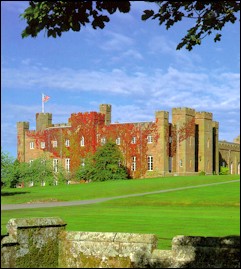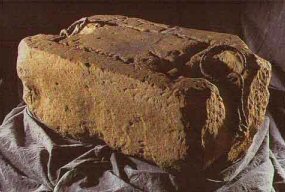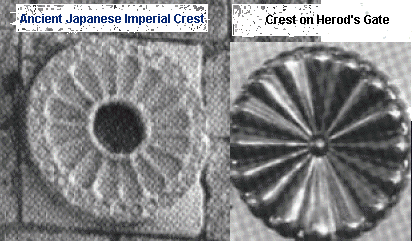There is much to be written on this. This is some of the background info on the topic, but there will be more in coming days. Certainly food for thought...
|
Lost Tribes of Israel
| |||
It all started in Genesis 49 when Jacob divided the
birthright. Judah (the ONLY tribe to be called Jews) only got the right to rule
and make the laws. Joseph got everything else, including all the
prophecies and promises to Abraham. Joseph's descendents were the nobility of
the 12-tribed nation. If you'll look at Ezekiel 23, you'll see that the
pre-eminent sister in God's eyes was Ahola, "the elder". God immediately
clarifies by telling us that Ahola is Samaria, the symbol of the northern
kingdom, called the House of Israel. When the whole nation of Israel, which
included the soon-to-be-called-Jews of the tribe of Judah, split soon after
Solomon's death, it was like Judah seceded from the twelve-tribed union and took
Benjamin with them. Israel really stayed pretty much the same, with the
Ephraimites in charge. Every time you read House of Israel, or Joseph, Ephraim,
Isaac, Samaria and other names it refers to the ten tribes of the northern
kingdom (the Nation of Israel).
One important link/key is the term Scythians (Celts); "the people who dwell in booths". Did the prophet Jeremiah (a Chief of Iber) die in Ireland? Did he travel there in 583-560 BC from Egypt around the same time of the destruction of Jerusalem, with: the scribe Baruch, Ebed-Melech, Tea Tephi (daughter of Zedekiah & heir to the throne-line of Pharez), and the son of the king of Ireland who had been in Jerusalem at the time of the siege? Did Jeremiah come to Ireland to build the nation Israel in the Isles of the West and to plant the royal line of David upon Israels throne in the person of Zedekiahs daughter, Tea Tephi? Tea Tephi is the name of the most celebrated queen in early Irish history. With her the lion came into Irish heraldry, an emblem of the Israelites, but especially of the tribe of Judah. With Tea Tephi also a most remarkable 400 pound stone came to Ireland called the Lia Fail, or stone wonderful, or Stone of Scone upon which the Irish line of kings were crowned until about 500 A.D. Thereafter it was carried to Scotland and used as coronation stone there till 1296 A.D. Then Edward I carried it to Westminster Abbey where it has been ever since, until just recently when it was returned to Scotland, as the Coronation Stone of Great Britain.
Tea Tephi married the Irish monarch, Eiochaid, the
Heremonn, thus joining the Pharez and Zarah branches of Judahs royal line, and
from them through the Irish and Scotch line of kings one can trace the descent
to George VI and show that Davids line did not lapse for Yahweh keep His
covenant of salt. (2 Chronicles 13:5)
Was the royal bloodline planted in Ireland? Could a female further the bloodline? Did Jeremiah bring the ancient Jewish coronation stone to Ireland (was the throne then overturned 3 times, and now is in London?)? Was it moved three times (finally to England) in fulfillment of Ezekiel's prophecy mentioned in chapter 21, verses 25-27? Did St. Andrew journey to Scotland? Is Israel today Ephraim? Is Britain and the United States Manasseh? Legend says Ireland was already populated by Hebrews before Jeremiah's arrival. Long prior to 700 B.C. another strong colony called "Tuatha de Danaan" (tribe of Dan) arrived in ships, drove out other tribes, and settled there. Later, in the days of David, a colony of the line of Zarah arrived in Ireland from the Near East. In light of this, imagine how fruitful the Irish potato famine has proven to be.... Or, is all the above a fabrication started via a book ("England the Remnant of Judah." London, 1861) by British-Israel expositor named Rev. F.R.A. Glover who combined two different people Tea and Tephi from two different time periods? Is the Worldwide Church of God behind furthering this confusion? Or, is it all true?? Also, consider this conflicting legend that there is a strong Jewish tradition that the prophet Jeremiah was stoned to death outside the city walls of Jerusalem - in the place known as Golgotha. Bible Probers should note: We think the "Annals" of Irish History (Annals of Ulster, Annals of the Four Masters, etc.) are only reliably historical from 1,000 A.D. onwards. All material relating to time periods before the time of St. Patrick (430 A.D.) is legend. However, there is some truth contained in the "Annals" prior to 1,000 A.D. The "Annals" go back to about 444 A.D., but written copies date only from the 1400's. For instance in these Irish "Annals" there are 18 records of eclipses and comets which all agree exactly to the day and hour with the calculations of modern astronomers. The oldest piece of consecutive Irish preserved in Ireland is found in the "Book of Armaugh", written about the year 812. See possible historic lineage here. Conclusion. Take note that, Jeremiah's commission included "to build and to plant". Legend frequently is steeped in fact, no matter how confusing. The Lost tribes went somewhere...Perhaps Ireland and western Europe....or even southern Russia. The Book of Tephi Teia Tephi is thought to have been the daughter (Tender Twig) of the king of Jerusalem (the Cedar) whom Jeremiah went forth to PLANT in Ireland after the ROOTING-OUT and DESTRUCTION of Zedekiah, the king of Jerusalem in c. 588 B.C. British occultist and Mason Lord Northampton, who has been atop the Temple Mount in Jerusalem conducting "Temple studies," candidly has admitted in interviews, that he is an adherent of British Israelism, which holds that the British oligarchy has mystical powers, because England was colonized by one of the lost tribes of Israel. "I think the tradition of the Kabbalah is very strong in England, because I think one of the lost tribes came to England. And I think you can spot them, quite clearly, in old English families. I am sure you can. I know they came to Ireland, then to the north of Wales, and then down into England. And then that became some of the oldest families we have." | |||
|
Stone of Scone (Destiny)
Traditionally it is said to have been
Jacob's pillow when he saw the angels of Bethel. Another legend suggests it was
brought to Scotland by Scotia, daughter of an Egyptian pharaoh. The most likely
explanation is that it was a royal stone brought from Antrim to Argyll and then
to Scone by Kenneth MacAlpin, the 36th King of Dalriada.

Carried
away from Scotland by English King Edward I in 1296, the 400-pound Stone of
Scone (pronounced SKOON) reputedly was the coronation seat of ancient kings of
Scotland and Ireland -- and, some say, the pillow of the patriarch Jacob. Some
say that the stone placed beneath the Coronation Chair was a fake, the true
Stone of Scone having been hastily hidden by the monks in an underground
chamber. The truth may never be known.
Scottish Nationalists
removed the Stone from Westminster in 1950 and returned it to Scotland. It was
recovered in the grounds of Arbroath Abbey four months later.
The Stone of Scone was
last used at the coronation of Queen Elizabeth II - and so it still performs its
ancient duty, and to far great effect, making not only the monarch of the Scots
but of Britain, Canada, Australia and New Zealand.
British Government Returned the Stone
to Scotland
On November
15, 1996, the Stone of Destiny, on which Scottish kings had been crowned since
time immemorial, was brought back to Scotland 700 years after the army of King
Edward I of England carted it off to Westminster Abbey in London. Now safely
ensconced in Edinburgh Castle, the 152 kg rock popularly known outside Scotland
as the "Stone of Scone" has joined the other Scottish royal regalia -- crown,
sceptre, sword and jewels -- in a closely-guarded museum.
The Stone
was last used in a coronation in Scotland in 1292, when John Balliol was
proclaimed King. Four years later, in 1296, the English monarch, Edward I
(infamous as the "hammer of the Scots," and nemesis of Scottish national hero
William Wallace) invaded Scotland. Among the booty that Edward's army removed was
the legendary Stone, which the English king apparently regarded as an important
symbol of Scottish sovereignty. The present Coronation Throne was made to house
the stone in 1301.

 Made of sandstone - Jacob's Pillow (Aka: Stone of Destiny)
But is the
stone that finally rests securely in Edinburgh Castle the real Stone of Destiny?
After so many centuries, it is impossible to know. According to one legend, the
Stone never left Ireland at all. One tale suggests that the original Stone of
Destiny was white marble, carved with decorative figures -- in no way resembling
the plain slab of yellow sandstone with a single Latin cross carved on it that
sat beneath the throne in Westminster Abbey for these past seven centuries. To
make matters more confusing, there may have been several copies made down
through the ages! It is entirely within the realm of possibility that some canny
Scots fobbed off a fake on Edward I, seven hundred years ago, hiding the
original coronation stone where it would never be found. One story particularly
satisfying to Scottish nationalists with long memories claims that Edward
actually took the rough rock used to hold down the cover of the cess-pit at
Scone Castle, and that subsequent English monarchs have ceremoniously seated
themselves on this medieval plumbing accessory for their coronations ever since
1308! At least one acknowledged copy of the "Westminster" Stone exists, on
public display at beautiful Scone Palace in
Perthshire, where it serves as a favorite roost for the elegant peacocks and
camera-toting tourists who stroll the grounds.
Edward I was aware of the
sacred Stone of Scotland and its strange history connecting it with Empire. He
knew the Scots venerated the Stone and were willing to die for it. He knew the
Scottish nation and believed there was an aura of fatality, inseparable from
their ancient Stone, which convinced them that their monarchy could not be
shaken while the relic was in the land; but it would suffer great changes were
the Stone removed. So he took the Stone after defeating them in battle. [This
was one of the causes of the rebellion led by William Wallace several years
later].
'On the surface he wanted to
persuade the Scots that the time for the dissolution of their kingdom had come,
and so dampen their hopes of ever recovering their national liberty. But
inwardly Edward dreamed of an Empire, and he its sovereign lord. Was there truth
in the prophecy about the Stone; he wanted it! To ensure that his secret desire
was not flawed, he had all the Scottish monuments destroyed, and books and
records burned.
'Unless the fates are
faithless grown,
And Prophet's voice be
vain,
Where'er is found this
Sacred Stone,
The wanderer's race shall
reign.'
'This detestable act was
abhorred by all who knew of it ('History of England,' by M. Rapine de Thoyras,
page 427). Refering to this, de Thoyras wrote 'Those records were such a loss to
the nation, to their posterity and to the world, as time could never replace.'
And he revealed that in a similar manner and from similar motives many valuable
Irish records were also consumed.
|




